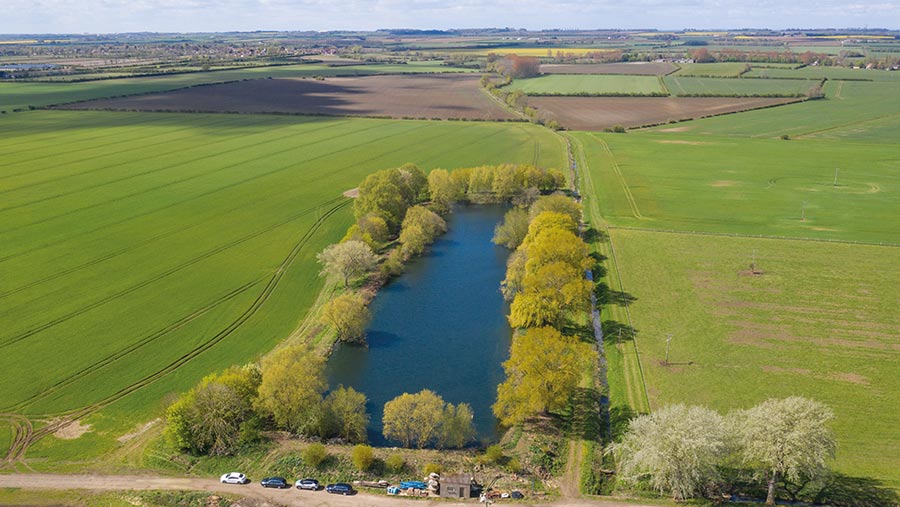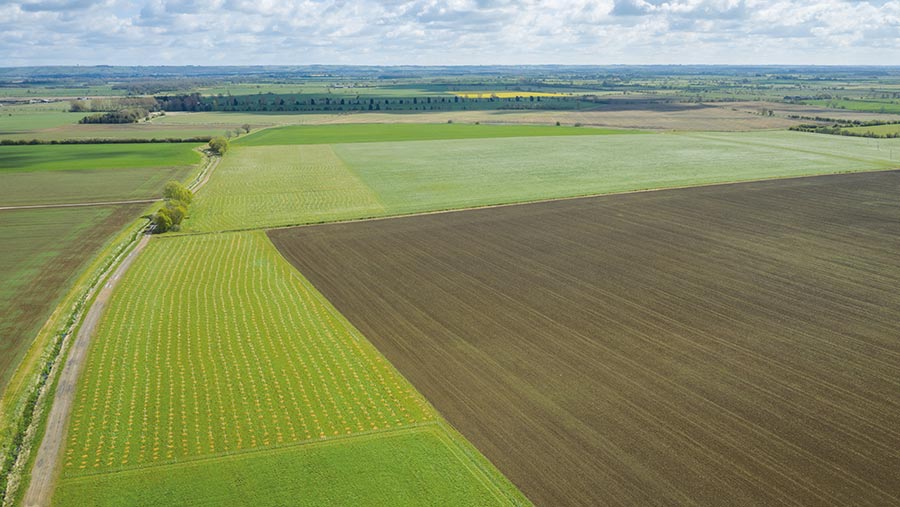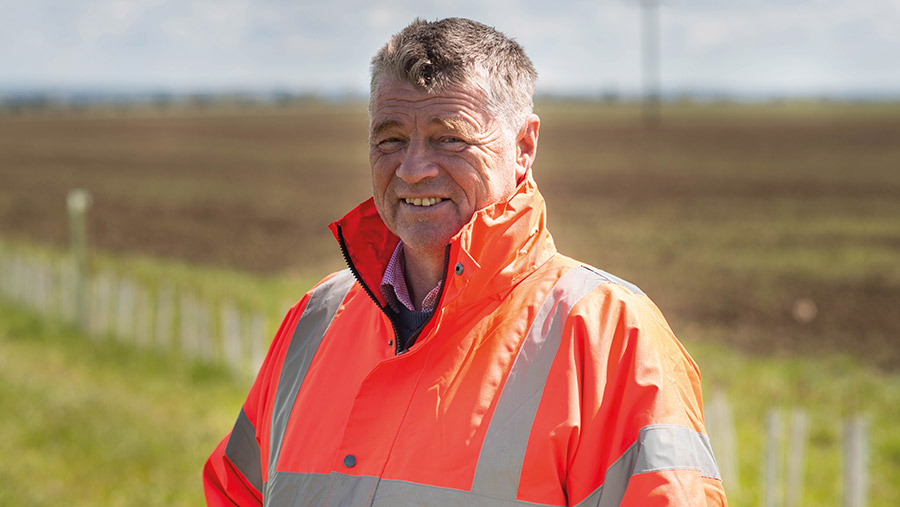Q&A: How funding for woods and hedges works
 Barff Farm’s reservoir and woodland plantations are linked by new hedgerows © Woodland Trust
Barff Farm’s reservoir and woodland plantations are linked by new hedgerows © Woodland Trust Man-made pressures and disease are putting a strain on woodlands and hedgerows, with consequences for wildlife populations and the farmed environment.
Farmland accounts for 72% of the UK countryside, so it is essential that those who manage it are keen to restore these valuable habitats.
However, schemes need to be accessible and commercially viable to encourage planting.
To address this, the Woodland Trust launched the MOREwoods and MOREhedges initiatives in 2010 and 2013, respectively, to bridge the guidance and funding gaps many farms came up against when pursuing woodland and hedgerow government grant schemes.
See also: Guide to funding for tree projects on farm
What funding and support do the MOREwoods and MOREhedges initiatives offer?
They subsidise up to 75% of the total cost of new woodland and hedgerow creation, and provide the advice and guidance needed for projects to be successful; from site suitability and species selection to planting, tree protection and management.
Who can apply, and what are the criteria?
Both landowners and farmers can apply, as long as eligibility criteria are met.
MOREwoods funding:
- Eligible projects must plant at least 0.5ha of new woodland, with an average of 1,000-1,600 trees/ha
- Total area can be made up of multiple blocks of land, each 0.1ha minimum
- No maximum limit – but other grant schemes may be better suited
- For new woodland creation only.
MOREhedges funding:
- Planting of 100-250m of new hedgerow is eligible, provided it connects directly with at least 0.2ha (0.1ha in Scotland) of existing or newly planted woodland or connects existing hedgerows with woodland, so extending an existing corridor
- For new hedgerow creation only.
Farms under MOREwoods funding may be eligible for up to 1,000m of hedging.

Some of the poorer land at Barff Farm, which was historically woodland, has been newly planted with MOREwoods funding © Woodland Trust
What’s involved in the application process?
Applications for both the initiatives are made online and take about 15 minutes to complete. Applicants will need to provide:
- A map of the area (site) to be planted
- A grid reference of the site.
Applications are assessed at monthly meetings, but it may take up to two months to hear if they have been successful.
What happens next?
Successful applications receive a visit from an adviser, who will assess the site and make recommendations of suitable native species, protection and planting objectives.
For woods, a site report is produced with the woodland design and a no-obligation quote. On signing the funding agreement, the farmer pays their contribution – typically 25% for self-planting – and then the trust orders the trees and protection.
Hedgerows are supplied as mixes of shrub varieties and vary in each region. For land where horses are kept, there is a horse-friendly mix.
Hedges also include subsidised trees to be planted every 6m within the hedgerow, which must be allowed to grow to full height. Species include English oak, sessile oak, silver birch, rowan, hornbeam and wild cherry.
When are the plants delivered?
The trees and shrubs are delivered on a date chosen by the farmer, along with the protection ordered, during the tree planting season.
This is typically from November to March, and they are supplied as saplings ranging from 20-60cm in height. All plants are grown and sourced in the UK and Ireland to reduce the risk of pests and diseases.
Who plants and how?
For those doing their own planting, the site adviser will recommend the planting density of woodlands. Planting methods can be followed using the online planting methods guide.
For farms creating woodland in England, Wales and Northern Ireland, the trust can arrange a contractor for projects larger than 1ha, subsidised at up to 60% of total woodland costs.
Farms in the Northern Forest (England) might be eligible for a higher rate.
Hedgerow planting cannot be contracted through the trust; farmers should follow the online planting methods guide.
What are the farmer’s obligations?
Farmers must commit to the care and management of the woodland and/or hedgerows for at least 30 years as part of the UK government’s ambitions to reach carbon net zero by 2050.
They can seek advice from the trust on weeding, watering, mowing and protection.
Basic Payment Scheme payments will no longer be claimable on the planted woodland, but the trust can help farmers identify schemes that enable the retention of grants.
When planting trees, it is also recommended to check planning regulations with the local council and Forestry Commission.
Guide to funding for tree projects on farm
See the guide to the main schemes available to UK farmers for funding tree projects
Case study: Robert Moore

Robert Moore © Woodland Trust
For an arable farmer in Lincolnshire, enhancing the farm for future generations is key to achieving a productive, sustainable future.
When Robert Moore (pictured) and his family bought Barff Farm in 1988 it was a highly productive 356ha arable operation growing only winter crops. But, over time, the management of blackgrass became increasingly difficult, and profits were affected.
In 2006 the Moores started an agricultural plastic waste recycling business. Then, in 2019, the pending subsidy phase-out sparked new talks about how the business could farm more sustainably and efficiently.
Decisions
The Moores began by identifying commercially productive land, with less-productive areas earmarked for alternative use. “We decided we needed to get hedges, trees and woods [which were removed in the 1970s] back in for a sustainable future in farming.”
Mr Moore applied to the MOREwoods initiative, and planting began in January 2021. He assessed drainage maps to make sure field drains were not compromised, and planted trees on the south side of the field’s adjacent track and stream to avoid shading any crops in the neighbouring field.
Native species were recommended to encourage wildlife. “We put a lot of rowan in for the berries which will provide a good wildlife food source,” he says.
The trees were planted in waves to replicate a natural wood. “The waves look really good, but next time I would also have straight lines to make irrigation possible,” he explains.
“We’ve suffered from dry periods and we haven’t been able to irrigate because of the woodland design; there will certainly be losses.”
To protect trees from pests, the vast majority have cortex guards. Mr Moore is responsible for woodland maintenance. “We have a tractor and a cutter and we cut between the trees – every other row – each time we go in,” he says. “Give yourself space to do that maintenance work.”
He has now planted 1,600-plus new trees a hectare across 5ha, as well as 3km of new hedgerows. “We put the woodland on the worst of the land, which was the historical woodland.”
The family has also put 81ha of underperforming land into permanent pasture, allowing the reintroduction of livestock to help combat blackgrass and act as a carbon sink.
Hedgerows
The farm also has a mature reservoir covering about 0.8ha, and Mr Moore wanted to create a network for wildlife by linking the reservoir and the woodland plantations with hedgerows.
Before approaching the trust for funding, he had already self-funded 2km of hedgerow in January 2020.
After receiving MOREwoods funding, he became aware of the MOREhedges initiative and, in February 2021, planted a further 1km of hedgerow.
“We have 3km in total, but plan to do more to provide more wildlife corridors between the habitats on the farm.”
Hedgerows are hawthorn-heavy, providing density and stability. “We also have rowan in the hedges, putting a tree every 20 yards or so – again it’s heavily berry-oriented for wildlife,” he says. PVC spirals are used to protect the hedging plants.
Benefits
The MOREwoods initiative provided a 60% subsidy, with Mr Moore choosing to use trust contractors for planting.
The hedgerows under MOREhedges funding received a 75% subsidy, with Mr Moore arranging his own contractor.
The woodland project took six months from application to planting the final tree. The subsidy allowed him to plant more woodland at lower cost, although the return on investment isn’t straightforward.
“The benefit is in taking bad land out of production and planting a viable resource that has values you can’t quantify – like the visual impact and effect on the farm as an overall asset,” he explains.
As the woodland and hedgerows mature, the benefits will grow. “The value of carbon sequestration and associated payments, alongside crop protection, soil fertility and the boost for wildlife, are all long-term gains.”
Thanks to Woodland Trust, whose sponsorship made it possible for us to run this article. Farmers Weekly had full editorial control of its content.
Woodland Trust MOREwoods scheme

Trees should be in every farmer’s toolbox. They boost productivity, resilience and the health of the environment – with no need to trade off with production. Make your planting project a success with the Woodland Trust’s MOREwoods scheme, funded by Lloyds Bank.
Plant at least 0.5ha and we could cover up to 75% of costs. An expert will visit to discuss the best options for your business and if eligible, arrange tree delivery and protection.
All trees are sourced and grown in the UK and Ireland. No obligation advice is available even if you decide not to plant.
